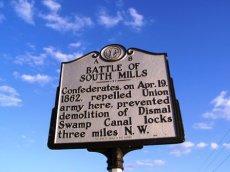April 19, 1862
Part of Union Army General Ambrose E. Burnside’s North Carolina expedition.
The Dismal Swamp Canal, opened to waterway traffic in 1805, became a “prize of war” during the Civil War. In the early months of war, southerners used the canal to transport much-needed supplies. W. F. Lynch, Commander of the C.S.S. Sea Bird, a side-wheel steamer, received naval supplies via the canal when he was in charge of a tiny fleet defending Roanoke Island. After Roanoke Island fell into Union hands on February 8, 1862, Lynch decided to take a position at Elizabeth City. However, on February 10th, units of Admiral Goldsborough’s fleet captured Elizabeth City and the Sea Bird was rammed and sunk by the U.S.S. Commodore Perry. Two other ships fled northward up the Pasquotank River to the Dismal Swamp Canal enroute to Norfolk. While C.S.S. Beaufort made it safely through the canal to Norfolk, C.S.S. Appomattox was two inches too wide to enter the locks. Rather than let his ship be captured by the enemy, the captain set it on fire.
Union forces did not attempt to destroy the locks of the Dismal Swamp Canal until two months later. According to The Rebellion Record, Frank Moore, Editor, it was known that “Rebel entrenchments and batteries to protect the canal” had been installed at South Mills. Also, this was the time of the “ironclads,” with the battle between the Monitor and the Merrimack at Hampton Roads on March 9, 1862. Word reached General Burnside, who had established a position in New Bern, that Confederates were building ironclads in Norfolk and intended to bring them south through the Dismal Swamp and Currituck Canals. Therefore, General Burnside ordered General Jesse L. Reno to move troops to South Mills and blow up the locks there, then proceed to the Currituck Canal and destroy its banks.
General Reno moved his command of 3,000 men from Roanoke Island on April 17th and transported them by water to Elizabeth City. From there, they marched north to South Mills, accompanied by three wagons loaded with explosive materials to be used on the locks. After an exhausting all-night march, at noon Reno’s men encountered the Third Georgia Regiment, commanded by Colonel A. R. Wright, about three miles below the locks at the edge of the woods at the north end of Sawyers Lane. On April 19th for five hours the 750 defenders withstood all Union assaults until their artillery commander, C.S. Captain W. W. McComas, was killed. Running low on ammunition and to avoid being flanked, Wright withdrew his troops to a new position behind Joy’s Creek, about a mile away. Unaccustomed to the oppressive heat, the Union forces did not pursue and, in fact, rapidly withdrew back to their transports near Elizabeth City, leaving their dead and wounded behind and the Canal intact. Estimated casualties: 114 US, 25 CS
Despite claims to the contrary, the Battle of South Mills was a failure for Federal troops because their mission was not accomplished, even though the smaller Confederate army retreated.
Soon afterwards, however, Norfolk surrendered on May 10, 1862, and Union troops transported goods on the Canal. In a “Letter from the Secretary of the Treasury in reference to the interests of the Government in the Dismal Swamp Canal,” Leroy G. Edwards, Collector of Tolls for the Dismal Swamp Canal Company, testified: “In the latter part of the summer of 1862, the U.S. forces took possession of the work. They gave us much trouble … goods were carried through under military permits. I asked payment of tolls, which were refused.”
During this time, a sizable number of Confederate sympathizers and deserted soldiers were in hiding in the Swamp, making periodic raids on Federal boats. Official Army records document on December 5, 1863, Brigadier General Edward A. Wild led forces from Norfolk to South Mills and Camden Court House to capture these rebel forces. However, the two small steamers carrying supplies for his forces were by “some unaccountable blunder … sent astray through the wrong canal” and did not catch up with General Wild until he arrived at Elizabeth City. Rebels eluded this expedition in the vastness of the swamp. All settlements discovered on this march were burned and confiscated, innocent men were hanged and women were taken as hostages. North Carolina Governor Zebulon B. Vance referred to General Wild’s actions as a “disgrace to the manhood of the age. Not being able to capture soldiers, they war upon defenseless women. Great God! What an outrage.” The Union forces returned to Norfolk on December 24, leaving a trail of destruction behind them.
Following the surrender at Appomattox on April 9, 1865, the Canal was returned to its owners in a deplorable condition.
Click here to read a first hand account, as published in the Augusta Chronicle May 1, 1862, of a confederate soldier present at the Battle of South Mills.












 Subscribe to RSS Feed
Subscribe to RSS Feed